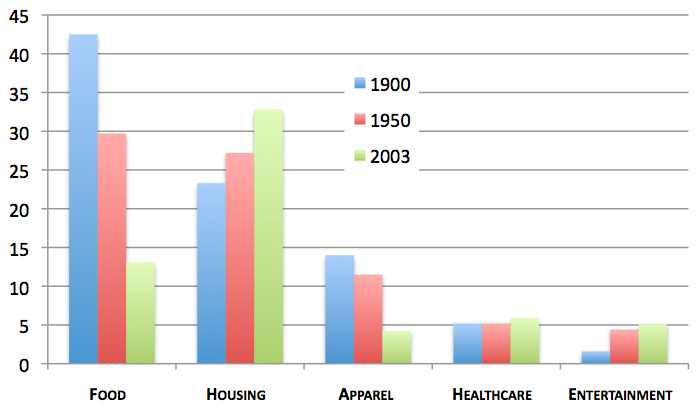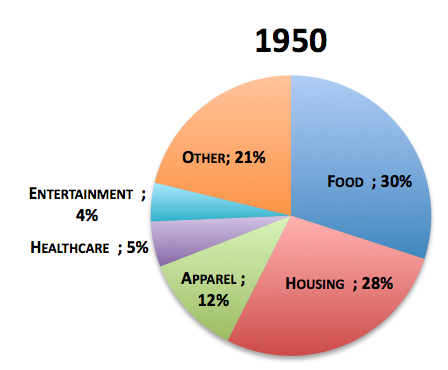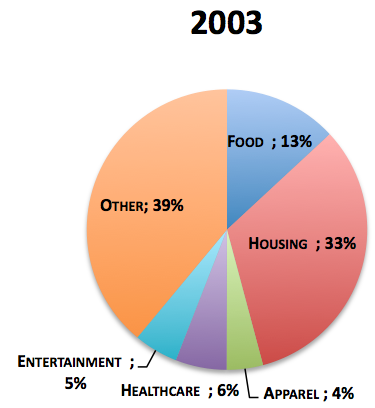When Did The United States Spend The Most Money
The 100-twelvemonth story of how a nation that feels poor got rich

A campaign affiche of President William McKinley in the year 1900; Wikimedia Eatables
You can learn a lot nigh somebody by looking through his receipts. Is he rich? Is she poor? Where does he store? What does she value?
Alas, the U.S. economy doesn't come with a receipt. GDP tells us how much stuff we produce. GDI, or gross domestic income, tells us how much coin we make. Merely these numbers don't tell us what the economy looks similar from the viewpoint of a typical household.
Fortunately, we take something that's very close to an aggregate receipt for the American family going dorsum more than than a century: "100 Years of U.S. Consumer Spending", a written report from the Bureau of Labor Statistics.
This is our story today: Information technology is a story about how spending on nutrient and wearable went from half the family budget in 1900 to less than a 5th in 2000.It is a story about how a nation that feels poor got and so rich. Here's the big film in one chart showing the share of family spending per category over the 20th century. The big story is that spending on food and clothes has fallen massively while spending on housing and services has gone upward.

HOW WE SPEND: 1900
The twelvemonth is 1900. The United States is a different state. We are near the cease of the Millennium, but in the "warp and woof of life," we are living closer to the 1600s than the 2000s, as Brad DeLong memorably put information technology. A quarter of households have running h2o. Even fewer ain the home they lived in. Fewer still have flush toilets. Ane-twelfth of households have gas or electrical lights, one-twentieth have telephones, one-in-ninety own a automobile, and nobody owns a television.

Families spend a whopping 80% of that on food, clothes, and homes.
In 1900, seen from perch of the Bureau of Labor Statistics -- which counts national jobs, income and spending -- the United States is similar one big farm surrounded by a cluster of small factories. Nearly half of the country works in agriculture. As for the budding services economy: There are more than household servants than sales workers. As for the women's rights movement: More than twice equally many households report income from children (22%) than wives (9%).
Over the next 100 years, the U.S. family got smaller, more reliant on working women and computers, less reliant on working children and farms, and, almost chiefly, much richer. Near 68-times richer, in fact. Household income (unadjusted for aggrandizement) doubled six times in the 20th century, or once every decade and a half, on boilerplate.
Simply to appreciate the transition in full, allow's showtime meet information technology halfway.
HOW WE SPEND: 1950

Meanwhile, the "making-stuff" economic system is at its noon. Nearly one-half of working men are craftsmen or operators. (The female labor participation rate is still below xx%.) Manufactory wages have grown past vii-fold since 1901, and they've about tripled since the Great Depression. Fabric manufacturing has never been college and will never exist higher. The year 1950 is its verbal peak. Apparel manufacturing would grow through the 1970s before collapsing in the terminal third of the decade. The U.S. was the making-stuff capital of the world, and our say-so probably felt indefinite.
Half a century later, factories, simply like farms earlier them, would become the victims of American efficiency.
HOW Nosotros SPEND: 2003
Information technology's become fashionable to consider the 1950s a golden historic period in American economics. Employment was total. Wages were rising. Manufacturing was strong. But if yous're the kind of person who likes clothes or food, then welcome to paradise.
 In the last l years, nutrient and apparel's share of family has fallen from 42% to 17% (and recall, we were near lx% in 1900) equally we've found cheaper means to eat and clothe ourselves. Food production got more than efficient, and we offshored the making of apparel to other countries with cheaper labor. Equally a result, apparel's share of the pie, which hardly inverse in the first half of the century, shrank in the second half by 2-thirds.
In the last l years, nutrient and apparel's share of family has fallen from 42% to 17% (and recall, we were near lx% in 1900) equally we've found cheaper means to eat and clothe ourselves. Food production got more than efficient, and we offshored the making of apparel to other countries with cheaper labor. Equally a result, apparel's share of the pie, which hardly inverse in the first half of the century, shrank in the second half by 2-thirds.
And so if the typical American family feels squeezed, what'southward squeezing us?
I have two answers: The first answer is housing and cars. Half of that orange "other" slice is transportation costs: generally cars, gas, and public transit. A century ago, if you recall, eighty% of families were renters and nobody owned a car. Today, more than 60% of families are dwelling house owners, and practically everybody owns a car.*
The other reply, which you tin can't run across every bit clearly in this chart, is health care. Health-care spending makes up more than 16% of the U.S. economy, but only 6% of family spending, co-ordinate to the CES. Ane reason for the gap is that about medical spending isn't out of our pockets. Employers pay workers' premiums and government foots the bill for the elderly and the low-income. Government spending on Social Security, Medicare, and Medicaid has quadrupled since the 1950s in the most meaningful measurement, which is share of GDP.
In short, health intendance costs are squeezing Americans. But the details of this squeeze elude the color-wheel higher up. Nosotros are paying for health care with taxes, borrowing, and compensation that goes to health benefits, rather than wages.
THE 100-Year Squeeze
In 1900, the Bureau of Labor Statistics counted three categories as necessities: housing, food, and apparel. In the last 100 years, nosotros've added to the list. Health care has become necessary. For most people, a car has get necessary. Even higher ed is a necessity for today's middle course.
Nosotros take new expectations for what our money should purchase. Nosotros have earned (literally) the correct to expect more from life in America.

Historical context shouldn't cheapen centre class suffering. Today's suffering is existent. Unemployment is loftier. Wage growth is apartment. We are squeezed by rising health care costs and scarcity of affordable housing in productive cities.
And yet, who can deny that we are richer? A century agone, we spent more one-half our coin on food and wearing apparel. Today, nosotros spend more one-half of our money on housing and transportation. Our ambitions turned from bread and shirts to buying and highways. We are all subtle victims of the expectations that 100 years of wealth accept bought.
_____
*Even for people who make up one's mind not to purchase, higher rent costs driven past popular coastal cities, constrictive urban policies, and a shortage of multifamily homes also increase housing costs
>
We want to hear what you lot think nigh this article. Submit a letter to the editor or write to letters@theatlantic.com.
/media/None/Derek_Thompson_grey/original.png)
Derek Thompson is a staff writer at The Atlantic and the writer of the Work in Progress newsletter.
Source: https://www.theatlantic.com/business/archive/2012/04/how-america-spends-money-100-years-in-the-life-of-the-family-budget/255475/
Posted by: wileylicep1943.blogspot.com

0 Response to "When Did The United States Spend The Most Money"
Post a Comment